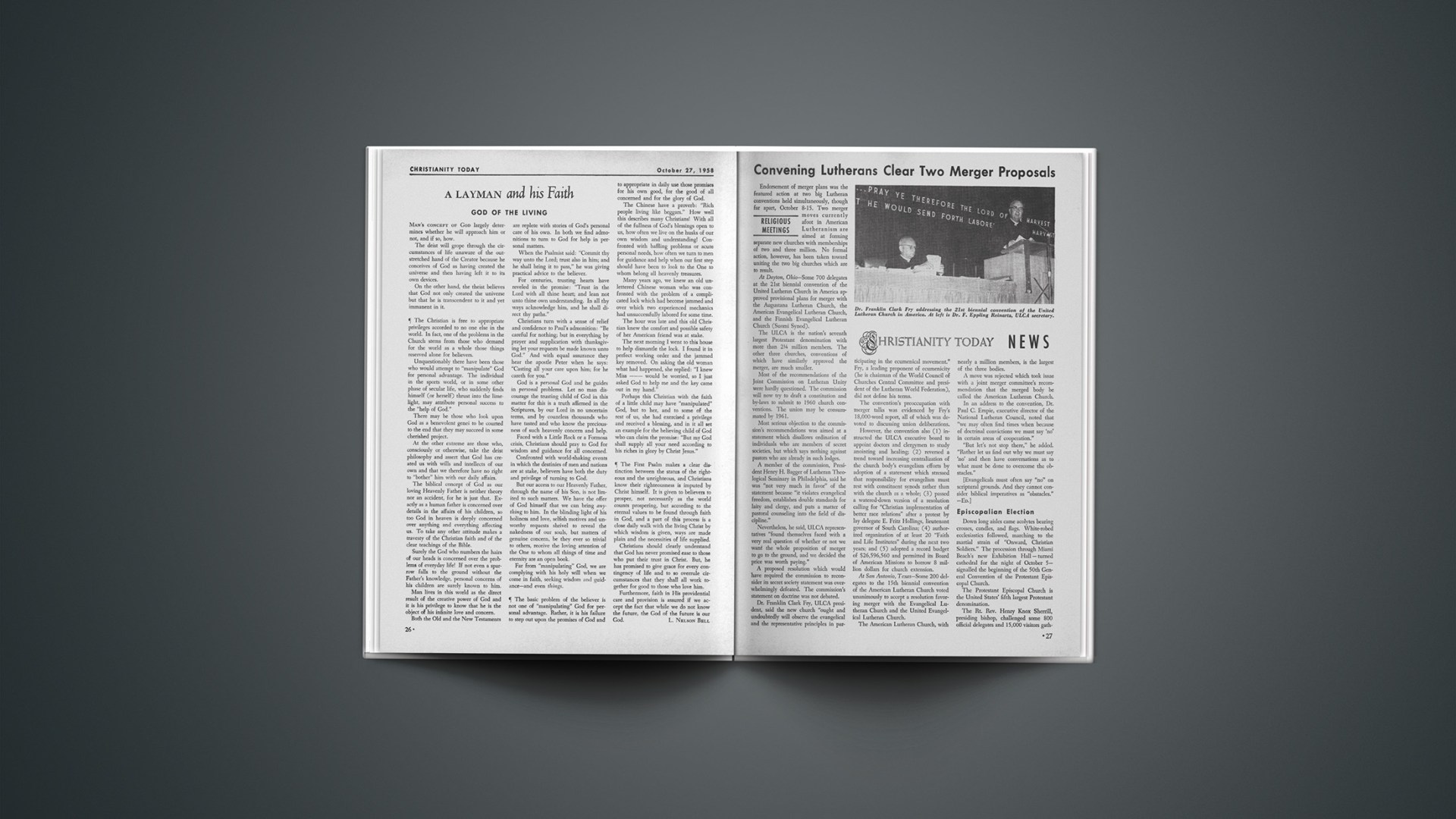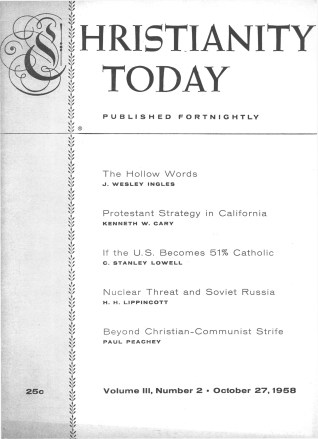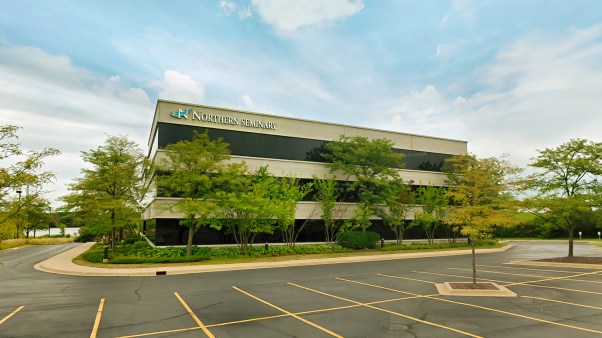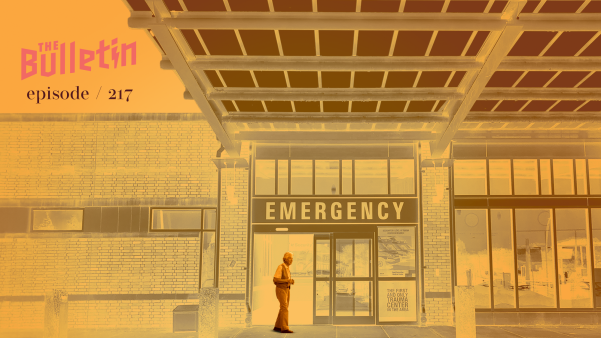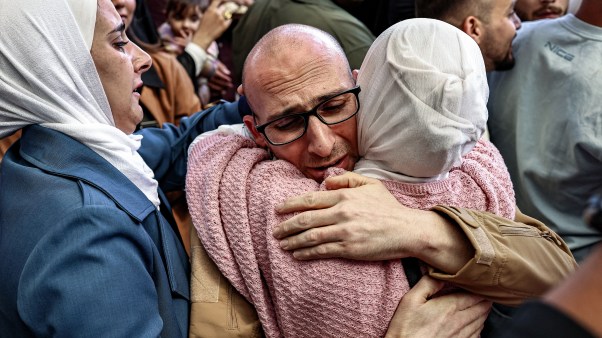NEWS
CHRISTIANITY TODAY
Religious Meetings
Endorsement of merger plans was the featured action at two big Lutheran conventions held simultaneously, though far apart, October 8–15. Two merger moves currently afoot in American Lutheranism are aimed at forming separate new churches with memberships of two and three million. No formal action, however, has been taken toward uniting the two big churches which are to result.
At Dayton, Ohio—Some 700 delegates at the 21st biennial convention of the United Lutheran Church in America approved provisional plans for merger with the Augustana Lutheran Church, the American Evangelical Lutheran Church, and the Finnish Evangelical Lutheran Church (Suomi Synod).
The ULCA is the nation’s seventh largest Protestant denomination with more than 2¼ million members. The other three churches, conventions of which have similarly approved the merger, are much smaller.
Most of the recommendations of the Joint Commission on Lutheran Unity were hardly questioned. The commission will now try to draft a constitution and by-laws to submit to 1960 church conventions. The union may be consummated by 1961.
Most serious objection to the commission’s recommendations was aimed at a statement which disallows ordination of individuals who are members of secret societies, but which says nothing against pastors who are already in such lodges.
A member of the commission, President Henry H. Bagger of Lutheran Theological Seminary in Philadelphia, said he was “not very much in favor” of the statement because “it violates evangelical freedom, establishes double standards for laity and clergy, and puts a matter of pastoral counseling into the field of discipline.”
Nevertheless, he said, ULCA representatives “found themselves faced with a very real question of whether or not we want the whole proposition of merger to go to the ground, and we decided the price was worth paying.”
A proposed resolution which would have required the commission to reconsider its secret society statement was overwhelmingly defeated. The commission’s statement on doctrine was not debated.
Dr. Franklin Clark Fry, ULCA president, said the new church “ought and undoubtedly will observe the evangelical and the representative principles in participating in the ecumenical movement.” Fry, a leading proponent of ecumenicity (he is chairman of the World Council of Churches Central Committee and president of the Lutheran World Federation), did not define his terms.
The convention’s preoccupation with merger talks was evidenced by Fry’s 18,000–word report, all of which was devoted to discussing union deliberations.
However, the convention also (1) instructed the ULCA executive board to appoint doctors and clergymen to study anointing and healing; (2) reversed a trend toward increasing centralization of the church body’s evangelism efforts by adoption of a statement which stressed that responsibility for evangelism must rest with constituent synods rather than with the church as a whole; (3) passed a watered-down version of a resolution calling for “Christian implementation of better race relations” after a protest by lay delegate E. Fritz Hollings, lieutenant governor of South Carolina; (4) authorized organization of at least 20 “Faith and Life Institutes” during the next two years; and (5) adopted a record budget of $26,596,560 and permitted its Board of American Missions to borrow 8 million dollars for church extension.
At San Antonio, Texas—Some 200 delegates to the 15th biennial convention of the American Lutheran Church voted unanimously to accept a resolution favoring merger with the Evangelical Lutheran Church and the United Evangelical Lutheran Church.
The American Lutheran Church, with nearly a million members, is the largest of the three bodies.
A move was rejected which took issue with a joint merger committee’s recommendation that the merged body be called the American Lutheran Church.
In an address to the convention, Dr. Paul C. Empie, executive director of the National Lutheran Council, noted that “we may often find times when because of doctrinal convictions we must say ‘no’ in certain areas of cooperation.”
“But let’s not stop there,” he added. “Rather let us find out why we must say ‘no’ and then have conversations as to what must be done to overcome the obstacles.”
[Evangelicals must often say “no” on scriptural grounds. And they cannot consider biblical imperatives as “obstacles.”—ED.]
Episcopalian Election
Down long aisles came acolytes bearing crosses, candles, and flags. White-robed ecclesiastics followed, marching to the martial strain of “Onward, Christian Soldiers.” The procession through Miami Beach’s new Exhibition Hall—turned cathedral for the night of October 5—signalled the beginning of the 50th General Convention of the Protestant Episcopal Church.
The Protestant Episcopal Church is the United States’ fifth largest Protestant denomination.
The Rt. Rev. Henry Knox Sherrill, presiding bishop, challenged some 800 official delegates and 15,000 visitors gathered for the 12-day, triennial meeting to face world problems realistically “in the light of the eternal truths of the Gospel.” And he emphasized an “even more primary aspect of the Gospel” than “the long tradition” of the “thought and practice” of the church, “namely the personal confrontation of the individual with the living Christ.”
In the convention’s first week, the House of Bishops faced the task of electing a successor to the distinguished Bishop Sherrill, who would reach mandatory retirement age in another month. The choice of the 146 bishops would be subject to confirmation by some 660 lay and clerical delegates comprising the House of Deputies, meeting in Miami Beach’s newly-opened Deauville Hotel. Indeed, there is constant interchange in messages between the two houses, for no legislation is final except it be approved by both. Under the bicameral governing system of the Protestant Episcopal Church, what may appear to be the mind of the church the first week may be negated the second.
After rejecting attempts to limit the term of the presiding bishop beyond the present retirement age restriction and defeating a perennial proposal to use the title of “archbishop,” the House of Bishops went into closed sessions early Saturday morning, October 11, to choose the church’s new leader from the unusually high number of nine nominees. After celebration of Holy Communion, a majority vote declared the presiding bishop-elect to be the Rt. Rev. Arthur C. Lichtenberger, Bishop of Missouri since 1952.
Somehow boyish in appearance, despite his gray hair and 58 years, Bishop Lichtenberger formerly served his church as a parish priest and rector, professor of New Testament in St. Paul’s Divinity School, Wuchang, China, and pastoral theology professor at Genetal Theological Seminary in New York City. He begins his new work November 15.
Describing himself to the press as a “middle-of-the-road churchman” with regard to the high and low church wings of Episcopalianism, he voiced strong sympathies for the cause of ecumenism—he is a member of the General Board of the National Council of Churches—and for the accomplishment of racial integration in church and school alike.
Meanwhile, the two houses headed for the second week’s important decisions, having resisted with much success the formidable temptations of sunny beaches, flights to Nassau, and NBC’s World Series.
F. F.
Protestant Panorama
• The West German government says refugees streaming in from behind the Iron Curtain represent their republic’s most “agitating” problem. Accordingly, the number of ministers counted among those who flee Soviet-controlled East Germany is a concern of church leaders. Last month the Council of the Evangelical Union warned clergymen that it is “irreconcilable” with ordination vows for pastors to leave parishes on their own account.
• The new Commission on Ecumenical Mission and Relations of the United Presbyterian Church in the U. S. A. was formally inaugurated at a meeting in New York last month. The commission replaces foreign missions boards and interchurch agencies of the two Presbyterian churches which merged last May. Its 66 members include lay men and women as well as clergy. Dr. Theophilus M. Taylor, Northern Presbyterian Church moderator, was elected chairman.
• The New York City Board of Hospitals, reversing an earlier decision by Commissioner Morris Jacobs, ruled that municipal hospitals may give birth control advice and provide contraceptive devices to women patients “whose health and life may be jeopardized by pregnancy and who wish to avail themselves of such health services.” The board had been under fire from many Protestant groups for refusing to allow the fitting of a contraceptive device for a Protestant diabetic woman patient.
• Dr. Christopher Dawson, noted British Catholic historian and author, took up new duties as Harvard Divinity School professor this month. He had been denied a visa, but it was finally granted … Dr. S. C. Eastvold, president of Pacific Lutheran college, said he has concluded after a visit with Dr. Albert Schweitzer that the famous philosopher and medical missionary is orthodox in his theology.
• Temperance leader Dr. Sam Morris begins a “Voice of Temperance” broadcast over the NBC radio network November 3. Morris says he has been trying to get a network temperance broadcast for 20 years … Jarrell McCracken, youthful president of Word Records, Inc., world’s largest religious record producing firm, will be featured guest on NBC radio’s “Faith in Action” program, November 2 … The Church of God’s “Christian Brotherhood Hour” is being beamed to Russia via Radio Tangier … The Free Methodist Church was hoping to air its “Light and Life Hour” (in Russian) to the Soviet Union starting November 1.
• Dr. Peter Rees Joshua, interim minister at Buena Memorial Presbyterian Church of Chicago, is in England and Wales for centenary services sponsored by the English Presbyterian Church marking the birth and evangelistic work of his distinguished father, Dr. Seth Joshua … Mr. and Mrs. James I. Detweiler and their three children, who live in Burbank, California, were named “The Methodist Family of the Year.”
• The Council for Christian Social Action of the United Church of Christ plans a $9,000,000 experimental project in desegregated housing in a key Northern city … The 10th annual Religion in American Life program is urging increased regular church attendance during November.
• Lutherans of Madagascar approved proposals that would give the island’s 800,000 Protestants official ties with the International Missionary Council … Dr. Reinhold von Thadden-Treiglaff, president of the German Evangelical Church Day Movement, says similar movements are spreading in Scandinavian countries. The movement, started at Essen, Germany, in 1950, is a permanent institution with the Evangelical Church in Germany. Its rallies are designed to encourage Christian laymen to participate actively in church and public life.
• Shotgun blasts fired from a passing car damaged the entrance to a building on the campus of Asbury Theological Seminary, Wilmore, Kentucky, last month. The incident was linked to outside opposition to the admittance of Negroes at Asbury … Northern Baptist Theological Seminary dedicated a $300,000 chapel September 23.
Hope And Heartbreak
His “home town crusade” now history, evangelist Billy Graham hopes to set aside coming weeks to prepare for campaigns in Australia and New Zealand early next year.
In the numerous overflow crowds, team members saw this fall’s crusade in Charlotte, North Carolina, as having been characterized by unusual public eagerness to get to the meetings. Among Christians, there was evidence of a wide hunger for more spiritual depth.
But the sight of milling throngs unable to get into Charlotte Coliseum also had a heartbreaking aspect. There was many a tear among Christians who brought unconverted loved ones to an evangelistic service, often after years of prayer and pleading, only to find the auditorium filled to capacity.
Attendance for the first three weeks of the crusade approached 300,000. There were 12,761 decisions after 24 days. The figures exclude special meetings such as one at Fort Bragg, North Carolina, which drew 10,000.
Originally planned with a tentative October 19 closing date, the meetings were extended through Saturday of that week. On Sunday, October 26, Graham scheduled an afternoon rally at the State House in the capital city of Columbia, South Carolina.
South Carolina Governor George Bell Timmerman said he was “shocked” to learn of plans for the rally, because, in his opinion, “such a meeting would break down racial barriers” and further the cause of integration. Nevertheless, Timmerman said he would not attempt to stop the plans.
Graham would not comment on the governor’s protest other than to say that he wanted to “preach the Gospel of Christ to all who were willing to come and hear.”
Sunday School Advance
“The Sunday School is doing more to combat juvenile delinquency than any other single agency in America today,” said Dr. Edward Simpson, outgoing president of the National Sunday School Association, in an address before the organization’s thirteenth annual convention in Des Moines, Iowa.
Some 4,500 pastors, Sunday School superintendents, teachers and church leaders were present during the week, October 6–10. They are part of a rapidly-growing evangelical movement to “revitalize the American Sunday School.” Some 30 denominations have officially joined the NSSA; active participants are to be found in all Protestant bodies.
Some 160 workshops, seminars and institutes dealing with every phase of Christian education in the local church drew thousands of observers in addition to registered delegates. More than 80 exhibits of Sunday School literature and supplies were thronged daily.
One of the most significant developments of the convention was the announcement of the Commission on Research in Christian Education that they had formulated a statement of the evangelical philosophy of Christian education which will be the basis for preparation of new textbooks and a new methodology distinctly evangelical in character.
Dr. Bert Webb of Springfield, Missouri, was elected president for 1958–59.
An expanding convention program calls for triple-city gatherings next year: at San Jose, California, Columbus, Ohio, and Atlanta, Georgia.
Descending Leadership
W. Wallace Smith was installed as president of the Reorganized Church of Jesus Christ of Latter Day Saints at the group’s biennial conference in Independence, Missouri, this month.
His selection as the new head had been designated in a document left by former president Israel A. Smith, killed in a highway accident this past summer.
W. Smith was installed after he had been endorsed as president by some 2,500 delegates at the conference. He is a grandson of Joseph Smith Jr., founder of the Mormon church, and a half-brother to the late I. Smith.
The Reorganized Church, with world headquarters at Independence, has a membership of about 170,000.
South America
For Colleges: Recognition
Church-related and other private universities in Argentina can grant professional degrees under a bill passed by the legislature in Buenos Aires just before its adjournment this fall. The legislation prompted outbursts of violence throughout the country.
Education in Argentina traditionally has been state-run. The new authority for private universities will immediately benefit many Roman Catholic educational programs, even though the granting of professional degrees will still be subject to control of public examination boards.
Uruguay, Bolivia and Paraguay remain as the only Latin American nations which deny autonomy to private universities.
Back To The Aucas!
Since the martyrdom of five young missionary men in January, 1956, perhaps no tribe in the world has presented a greater challenge for Christians than the Auca Indians of Ecuador.
South American missionaries and friends have been praying for the savage Aucas for some 35 years. No one dared to enter Auca territory until three years ago. The initial contact attempt ended when Aucas killed the five missionaries on the sands of “Palm Beach,” along the Curaray River.
The slayings stirred the Christian world and set off intensive prayer that the hostile tribe might yet be reached with the Gospel. Missionaries stayed as close to the Aucas as possible by maintaining an outpost at Arajuno. Missionary Aviation Fellowship planes periodically flew over Auca territory dropping gifts.
A year ago, the mission station at Arajuno heard that two Auca women had left their tribe and were staying with the semi-civilized Quechua Indians. Mrs. Elisabeth Elliot, wife of one of the slain missionaries, immediately set out with a group of Quechuas to meet the two Auca women. She found one of them to be an older woman who had been seen at “Palm Beach” in January, 1956.
The Auca women lived with missionaries thereafter, along with Miss Rachel Saint, sister of one of the martyrs, and Dayuma, another young Auca woman who has been away from her native tribe for 12 years. Dayuma was baptized earlier this year during a trip to the United States. The three Auca women have been helping missionaries learn the Auca language.
Last month, Dayuma and the other two Auca women, Mintaka and Mankamu, decided to go back and witness to their people. The missionaries wondered if they would ever be seen again.
With the Auca women went three pups, gifts for their people, and food for themselves. They were prepared for a long journey, but how would it end?
Five days after their departure down the jungle trail, a flight was made over the Auca settlement. From the plane, Mrs. Elliot saw a native woman waving vigorously at the plane. Mrs. Elliot thought the woman looked like Mankamu, but she was not certain. Several other flights were made, but there was no further recognition from the natives on the ground. It had been arranged to drop a telephone to Dayuma, but Dayuma could not be found.
On Thursday, September 25, Mrs. Elliot was hanging out the wash when a Quechua Indian appeared.
“Good morning,” she greeted him. “Why have you come?”
“For nothing,” he replied.
“Didn’t you even bring us any news about the Aucas?”
“Oh, yes, they have come and have brought others with them. They have stopped down at the Nushino River to bathe and they asked me to come on ahead to tell you.”
Mrs. Elliot and Mrs. Marjorie Saint, also a widow of the “Palm Beach” killings, set out to meet the party. They had not gone far before they heard the strains of “Jesus Loves Me”—in English with an Auca accent! It was Dayuma, followed by Mintaka, Mankamu, and four other women with three boys!
Afterwards Mrs. Saint reported:
“We learned that they hadn’t been seen from the plane because they were so tired that they had stopped at a place a few hours walk short of the Auca houses and had sent Mankamu on ahead, perhaps to throw in the proverbial hat. It was she that Betty had seen waving.
“Dayuma saw her mother once again after 12 years. The Aucas told her they would like Betty and Rachel to come in—that they never knew anyone truly wanted to be their friends.
“One man told them that he cried when he heard that some had killed the five foreigners. He said he waited a while and then went to the beach and felled a tree so that no more foreigners could come in and be killed.
“They also told of killing another foreigner just recently, Mr. Tremblay from Canada.” (See CHRISTIANITY TODAY, August 18, 1958.—ED.)
On Monday, October 6, Mrs. Elliot and Miss Saint accompanied Dayuma, Mintaka, and Mankamu back into the Auca jungles. After two days of travel, they set up camp near Auca huts.
Reported CHRISTIANITY TODAY News Correspondent Abe C. Van Der Puy on October 11:
“There was a good radio contact with Betty Elliot today.”
Continental Europe
Civil Pressures
Like the early Christians, European evangelicals occasionally find legitimate claims challenged by civil authorities. Last month, near scenes of the earliest Church-State struggles of Christendom, two evangelical communities saw force applied against property rights.
Greek police moved in one morning on a park claimed by an evangelical congregation near Thessalonica, where centuries ago the preaching of Paul and Silas was met by a community uproar stimulated by religious leaders. Some 500 women turned out to defend the park and one of them was injured before police withdrew. The incident happened at Katerini, where a park stands between a church and an orphanage, all located on land granted to Greek evangelical refugees from Pontus, Asia Minor, in 1922. The Greek government has disputed the evangelicals’ claim.
At Sant’-Angelo-in-Villa, Italy, a community where Baptists outnumber Catholics, the Rev. Graziano Cannito and his congregation have been trying for a year to erect a new, 250-seat church building. Although the Ministry of Public Works in Rome has authorized the project, Cannito has been unable to get a local permit. He appealed to the courts. He was threatened with arrest. Still no permit!
“Meanwhile,” Cannito wrote last month to the Southern Baptists in the United States, with whom his church is affiliated, “the hatred toward us evangelicals is such that the judge, who for a month has been on vacation at Terracina, on the coast, has still busied himself with making me stop the work on the church every now and then.”
Protestants In Poland
Polish Protestants chalked up two firsts for themselves last month:
—A Protestant book store was opened in Warsaw.
—An interdenominational service in Warsaw drew pastors from several church groups, including Lutheran and Reformed representatives.
For Sweden: Women Clergy
The General Assembly of the state Lutheran church of Sweden last month accepted government-approved legislation permitting ordination of women. The action by the church body, which wields a veto power over bills affecting it, enables the measure to become law.
Ordination of women in Sweden has been a perennial issue. This year the church’s legislative veto power likewise became an issue. Had it been exercised again, a measure to abolish the right probably would have been introduced into the legislature.
Moves were afoot to split the church and break the law, if necessary, to evade its implementation. Some observers felt, however, that the law does not require bishops to ordain women if such is against their convictions.
Gains And Losses
Following Lke
President Eisenhower had an intense round of church-related activities starting Sunday, October 12, when he participated in the cornerstone laying at the Interchurch Center (described below) in New York. Using a silver trowel, the President mortised into the new ecumenical center’s 2½-ton cornerstone of Alabama limestone a 150-pound piece of marble, which was presented by the Greek Orthodox church as a relic of ancient Corinth.
The following day, Mr. Eisenhower was back in Washington to accept an honorary doctor of laws degree from Georgetown University, operated by the Jesuit order of Roman Catholic priests.
On Tuesday, the President paid tribute to Pope Pius XII by attending a “solemn pontifical requiem mass” at St. Matthew’s Cathedral in Washington.
Dr. Carl McIntire, president of the International Council of Christian Churches, protested the President’s participation in the cornerstone laying as discriminatory in favor of one religious group. Other observers felt that no more significance should be attached to the President’s participation in the cornerstone laying than to his attendance at a mass for the pope, or his participation a year ago at the dedication of a Moslem temple in Washington.
On October 1, which Mr. Eisenhower had proclaimed as “National Day of Prayer,” the President attended a special service in Washington’s National Presbyterian Church. Despite the fact that a number of other government leaders also attended, the church was more than two-thirds empty.
Interchurch Center
The Interchurch Center in New York City is being built at a cost of $20,000,000 as the most impressive material symbol of the ecumenical movement in the United States. Chief occupants: the National Council of Churches and the U. S. Conference of the World Council of Churches.
Responsibility for development and operation of the building rests with the Interchurch Center, Inc., formed in liaison with the National Council of Churches’ 24-member committee on headquarters location. Corporation board chairman is Edmund F. Wagner, layman treasurer of the United Lutheran Church in America and president of the Seamen’s Bank for Savings, New York.
Modern Translations
Publishers report a great surge of interest in new translations of Scripture.
Among popular language New Testaments, the 575-page The New Testament in Modern English of J. B. Phillips (reviewed on page 35) is in greatest demand. The Phillips compilation (of his earlier Letters to Young Churches, The Gospels, The Young Church in Action, and The Book of Revelation) hit the list of top ten best-sellers this month. Macmillan’s price: $6.
Demand is also great for a new translation known as The Amplified New Testament, released by Zondervan June 4. The Grand Rapids firm says current sales exceed 3,000 per week. By the end of the year, some 110,000 copies will be in print.
Publication of the Phillips New Testament was prompted by popular reception to his earlier sections. Letters to Young Churches, the translation of the Epistles, has sold more than a million copies in ten years.
John Bertram Phillips is a pipe-smoking, Anglican clergyman who began translating during World War II to make the Bible more understandable for his younger English parishioners. He holds the B.A. degree from Emmanuel College and the M.A. from Ridley Hall. Since 1957 he has been Canon Prebendary of Chichester Cathedral.
Translator Phillips feels that “some scholars, at least, have lived so close to the Greek text that they have forgotten their sense of proportion.”
“I doubt very much,” he writes in the foreword of the complete work, “whether the New Testament writers were as subtle or as self-conscious as some commentators would make them appear. For the most part I am convinced that they had no idea that they were writing Holy Scripture.”
Zondervan’s Amplified New Testament grew out of scholarly despair that “the Greeks have a word for it, but we don’t.” The aim was to include various shades of meaning in cases where a single English word is inadequate. This is accomplished by addition within the text of extra words in brackets, parentheses, and dashes.
The 995-page Amplified New Testament, retailing at $3.95, was sponsored by the Lockman Foundation, a non-profit, California corporation “established for the express and stated purpose of promoting evangelism, Christian education and benevolence.” Research was done with the aid of a board of evangelical scholars led by Mrs. Frances E. Siewert, a learned Bible teacher. Twelve thousand hours and $25,000 were spent in preparations for printing.
Zondervan also is preparing for release January 30 The Holy Bible—The Berkeley Version in Modern English. The Berkeley Version, which carries explanatory annotations as footnotes, first appeared as a New Testament in October, 1945. It represents the “retirement” project of Dr. Gerrit Verkuyl, Presbyterian educator and Bible scholar from Berkeley (which gave rise to the title), California. Verkuyl studied under Dr. Benjamin Warfield at Princeton Theological Seminary, did graduate work on the ethics and psychology of Clement of Alexandria at Leipzig University, then went to the University of Berlin.
“At least two valid reasons for fresh translations are clear to the thoughtful reader,” says Verkuyl. “First, the discovery of earlier and more reliable Greek manuscripts than those from which our Authorized Version was translated more than three centuries ago. Second, the need of employing current words and phrases rather than those that have become obsolete.”
Still the leader among modern language translations is the Revised Standard Version, which has been selling at the rate of more than a million a year.
Total sales figures for King James Version are unavailable. The Nelson firm concedes, however, that the RSV still has a long way to go to catch up.
Wicked Moon Shots?
From the Pentagon this month came an iniquitous affirmation: Moon rocket firings “must” proceed on Sundays if scientists deem conditions favorable, God notwithstanding.
Director Roy W. Johnson, of the Defense Department’s Advance Research Projects Agency, said he does not feel that the Lord will frown upon Sunday moon rocket launchings because “what we are doing to secure the blessings of our way of life is necessary.” Noteworthy, nevertheless, was Johnson’s implicit admission that lunar firings on the Lord’s Day are sin:
“If all conditions are met on a Sunday, we must proceed, asking the Lord’s forgiveness for this rude imposition on his day.”
The statement followed a resolution forwarded President Eisenhower and the Defense Department by the First Methodist Church of Conyers, Georgia.
The Rev. J. Douglas Gibson and his congregation said they deplored the selection of Sunday, August 17, for the initial attempt at getting a rocket to circle the moon. The rocket exploded 77 seconds after launching. (The second U. S. attempt, which came on Saturday, October 11, soared far enough into space to return valuable scientific data.)
The resolution urged “those in charge of research to desist from the use of Sunday as a day to proclaim to the world our greatness.”
Four Versions Of John 3:16
KING JAMES
For God so loved the world, that he gave his only begotten Son, that whosoever believeth in him should not perish, but have everlasting life.
REVISED STANDARD
For God so loved the world that he gave his only Son, that whoever believes in him should not perish but have eternal life.
PHILLIPS
For God loved the world so much that he gave his only Son so that everyone who believes in him should not be lost, but should have eternal life.
AMPLIFIED
For God so greatly loved and dearly prized the world that He [even] gave up His only begotten Son, so that whoever believes in (trusts, clings to, relies on) Him may not perish—come to destruction, be lost—but have eternal (everlasting) life.
[In the Amplified New Testament, parentheses and dashes “signify additional phases of meaning included in the Greek word, phrase or clause.” Brackets contain “justified clarifying words or comments not actually expressed in the immediate Greek text.” Italics indicate words found in the King James, “but generally omitted now because they are not adequately supported by more recent scholarship,” or, in the case of connectives, the indication of italics is that “the word itself is not in the Greek text, but it is used to connect additional English words indicated in the same Greek word.” Other explanations are given in footnotes.—ED.]
Catholicism Under Pius Xii
If Vatican figures are accurately indicative, the world-wide membership of the Roman Catholic church increased by more than 40 per cent during the 19-year reign of Pope Pius XII.
When Eugenio Pacelli became pope in 1939, Roman Catholics claimed some 354,000,000 adherents. Last month, Vatican officials publicly estimated Catholic population at more than 468,000,000. The latest total excludes Catholics in Iron Curtain countries; when added, these easily swell the figure over half a billion.
The rule of Pius XII saw numerous pronouncements which went beyond scriptural license. He expanded Roman dogma by defining the Virgin Mary’s presumed assumption into heaven in body and soul.
He also issued declarations that modern scientific progress should be employed to advance spiritual interests.
The pope’s death in the pre-dawn of October 9 was announced only after Nicola Cardinal Canali, major penitentiary, had performed the ancient ritual of tapping the skull of the dead pontiff with a silver hammer and entreating him several times to rejoin the living.
The last recorded words of Pius XII were, reportedly, “Pray, pray, pray that this unhappy situation for the church may end.”
It was not certain what he specifically meant by “this unhappy situation.”
A few weeks before his death, the pontiff called the lack of aspirants to the priesthood in Latin America “a most urgent problem.” Several other Latin American trends, among them the growth of Protestantism, also are disturbing Roman Catholic authorities. A conference of Latin American bishops was scheduled for November 11–17 in Rome to launch a drive against these “mortal dangers.”
Next At Princeton
Dr. James I. McCord was named this month to succeed Dr. John A. Mackay as president of Princeton Theological Seminary.
McCord is dean of Austin, Texas, Theological Seminary, long associated with Southern Presbyterians but now projected as a joint effort with the United Presbyterian Church in the U. S. A.
Mackay is retiring after more than 20 years as president of Princeton, associated with Northern Presbyterians but described as “ecumenical in spirit.”
McCord will take office next fall if his appointment is confirmed by the General Assembly of the United Presbyterian Church in the U. S. A. He holds degrees of doctor of divinity from Austin and Knox Colleges and doctor of theology from the University of Geneva. He represented the Presbyterian Church in the U. S. at the initial meeting of the World Council of Churches in 1948 and at the Faith and Order Conference in Oberlin in 1957.
Princeton has its largest enrollment in history this year—495 students, representing 20 nations and 50 denominations. The physical plant is being expanded and improved at a cost of more than 3 million dollars.
McCord was appointed by the seminary’s board of trustees. His name was introduced to the trustees by a special committee headed by Dr. Eugene Carson Blake, stated clerk of the Northern church.
McCord, a native Texan, has been dean at Austin since 1944.
Perils Of Service
The Rev. Kornelius Isaak, 30-year-old native Paraguayan missionary, was speared and fatally wounded last month by savage Morro Indians whom he was trying to win for Christ. The Morro Indians of northwestern Paraguay have never been reached with the Gospel. Isaak was of the Mennonite Brethren, married, and the father of three children.
Miss Anna-Greta Stjarne, 31, of the Swedish Evangelical Mission, was murdered by bandits near Addis Ababa, Ethiopia, some time in September, according to a report by Ecumenical Press Service. Miss Stjarne had just returned to Ethiopia after a year’s furlough in Sweden to begin her second five-year term, the report added.
In Algeria, an American Methodist missionary, the Rev. Lester E. Griffith, was kidnapped by nationalist rebels and held for more than a month. He was released last month in good health.
People: Words And Events
Deaths: Pius XII, 82, whom Roman Catholics claim as their church’s 261st pope, at Castel Gandolfo, Italy … Dr. George K. A. Bell, 75, former Anglican Bishop of Chichester and honorary president of the World Council of Churches, at Canterbury, England … Dr. Otto justice Baab, 62, professor of Old Testament interpretation at Garrett Biblical Institute, in Chicago … the Rt. Rev. Karl Morgan Block, 71, Protestant Episcopal Bishop of California, in San Francisco … Bishop Volkmar Herntrich, 49, of the Lutheran Church of Hamburg, Germany, and member of the World Council of Churches Central Committee, near Nauen, East Germany … Dr. James McGinlay, 57, evangelist and Bible teacher, in Portland, Oregon … Minnie Webster Corbett, 72, Presbyterian missionary leader, in New York … Mrs. Herbert Welch, 92, wife of the senior bishop of The Methodist Church, in New York.
Appointments: As dean of Duke Divinity School, Dr. Robert E. Cushman … as visiting professor in the Department of Bible and Religion, Syracuse University, Dr. Rudolf Bultmann, professor emeritus of New Testament at the University of Marburg, Germany … as Roman Catholic Archbishop of Chicago, Albert Gregory Meyer … as deputy chief of Army chaplains, Chaplain (Colonel) William J. Moran, Roman Catholic … as chaplains-general of Canadian armed forces, Brigadier John W. Forth, Anglican, and the Rev. Ronald Mac-Lean, Catholic … as visiting professor of homiletics at University of Chicago Federated Theological Faculty, which claims to be the only truly interdenominational (Baptist, Disciples of Christ, Congregational, Unitarian-Universalist) university-centered school of theology in the world, the Rev. William B. J. Martin … as professor of psychology and Christian education at Bethany Biblical Seminary, Dr. Jesse H. Ziegler … as pastor of the Wornall Road Baptist Church, Kansas City, Missouri, Dr. Theron D. Price, former professor of church history at Southern Baptist Theological Seminary, Louisville.
Elections: As president of the Primitive Methodist Church, U. S. A., the Rev. Thomas W. Jones … as bishop of the Evangelical Congregational Church, Dr. Harold H. Scanlin … as presidents of editor and manager sections, respectively, of the National Lutheran Editors’ and Managers’ Association, Dr. L. F. Blankenbuehler and E. M. Laitala.
Retirement: As editor of the Baptist New Mexican, Lewis A. Myers.

